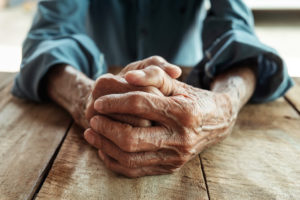Historical Classes

Table 1: Intentional and nonintentional risk factors for self-neglect
Historically, three classes of SN have been described, non-intentional (passive), intentional (active), and Diogenes Syndrome (Ridings, 2008). Table 1 differentiates between intentional and non-intentional self-neglect (Day & Leahy-Warren, 2008).
Non-Intentional Self-Neglect
Non-intentional (passive) self-neglect can be caused by poor health (Ridings, 2008). For example, mental conditions can make an individual confused. When they are confused, they may not take care of themselves or their house. Over time, their bodies become dirty and homes become filthy and cluttered. The individual does not understand what is happening. He or she does not actively choose to be filthy or unsafe (Day & Leahy-Warren, 2008). A similar result may happen if the individual has become blind as a result of poorly controlled diabetes Tarr, Kaul, Chopra, Kohner, & Chibber, 2013).
Intentional Self-Neglect
Intentional (active) self-neglect is when an individual is of sound mind and body and chooses to live in filth and dangerous conditions. The individual may choose not to bathe, take necessary medications, or clean or maintain their home, even though they know they should. These decisions may be an attempt at maintaining control, a lifestyle choice, a personality type, or a reaction to the fear of going to a nursing home (Day & Leahy-Warren, 2008; Ridings, 2008).
Diogenes Syndrome

Self-Neglect has been difficult to characterize because its appearance is so variable
Diogenes Syndrome is the third type of self-neglect (Amanullah, Oomman, & Datta, 2009). It is named after a 4th century Greek philosopher (see History of Self-Neglect). Diogenes Syndrome represents the worst form of passive SN and is associated with hoarding (Amanullah et al., 2009; Dyer, Pickens, & Burnett, 2007). Individuals with Diogenes Syndrome usually have mental illness (Amanullah et al., 2009). People with certain personality traits, such as being aloof, may have higher risk for this severe form of self-neglect (Cipriani, Lucetti, Vedovello, & Nuti, 2012).
Individuals with Diogenes Syndrome live in extreme poverty-like conditions (Cipriani et al., 2012). They often have no running water or electricity due to lack of maintenance or paying bills. Hoarding animals, trash, and rotting food is common (Cipriani et al., 2012). They refuse support and medical treatments, resulting in poor health. These individuals do not believe that there is a problem and underestimate danger. They keep doors open and unlocked (Cipriani et al., 2012).
Four Subtypes
Four unique subtypes of elder self-neglect were described in 2014:
- Physical and medical (~50%),
- Environmental (22%),
- Global (21%), and
- Financial self-neglect (9%) (Burnett et al., 2014).
The physical and medical self-neglect subtype demonstrate few mental health problems (Burnett et al., 2014). Addressing their physical and medical needs may allow them to remain in their homes. The environmental neglect subtype include hoarders, and are at increased risk for falls (Burnett et al., 2014). Global self-neglect occurs more often in Caucasians and in individuals with mental health problems. Financial and environmental self-neglect were more common in the African American population (Burnett et al., 2014).
ReferencesAmanullah, S., Oomman, S., & Datta, S. S. (2009). “Diogenes syndrome” revisited. The German Journal of Psychiatry, 12, 38-44.
Burnett, J., Dyer, C. B., Halphen, J. M., Achenbaum, W. A., Green, C. E., Booker, J. G., & Diamond, P. M. (2014). Four Subtypes of Self‐Neglect in Older Adults: Results of a Latent Class Analysis. Journal of the American Geriatrics Society, 62(6), 1127-1132.
Cipriani, G., Lucetti, C., Vedovello, M., & Nuti, A. (2012). Diogenes syndrome in patients suffering from dementia. Dialogues in Clinical Neuroscience, 14(4):455–460
Day, M. R., & Leahy-Warren, P. (2008). Self-neglect 1: Recognizing features and risk factors. Nursing Times, 104(24), 26-27.
Dyer, C. B., Pickens, S., & Burnett, J. (2007). Vulnerable elders: When it is no longer safe to live alone. The Journal of the American Medical Association, 298(12), 1448-1450.
Ridings, J. (2008). Using concept mapping to identify elder self-neglect program evaluation information for Metro Chicago. ProQuest.
Tarr, J. M., Kaul, K., Chopra, M., Kohner, E. M., & Chibber, R. (2013). Pathophysiology of diabetic retinopathy. International Scholarly Research Network Ophthalmology, 2013, 1-13. doi:10.1155/2013/343560
Last updated: June 6, 2020 at 15:20 pm by
I. M. Abumaria, Doctor of Nursing Practice
Version 2.00